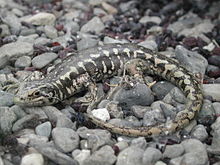Oligosoma otagense
| Otago skink | |
|---|---|
 |
|
| Scientific classification | |
| Kingdom: | Animalia |
| Phylum: | Chordata |
| Class: | Reptilia |
| Order: | Squamata |
| Family: | Scincidae |
| Genus: | Oligosoma |
| Species: | O. otagense |
| Binomial name | |
|
Oligosoma otagense McCann, 1955 |
|
 |
|
| Synonyms | |
|
|
The Otago skink (Oligosoma otagense) is a rare, endangered species of large skink in the family Scincidae, found in the rocky canyons and grassy patches of Central Otago, New Zealand.
Otago skinks are large compared to other New Zealand skinks, growing up to 12 inches (30 cm). They are marked with distinctive black, yellow, and green spots, which provides excellent camouflage in their rocky habitat of lichen-covered rocks and schist outcrops. Juveniles have more of a yellow base with dark blotches and shorter limbs. Like most skinks, Otago skinks are omnivores and feed on a wide variety of insects, fleshy fruits, flower petals, or even other small reptiles. They are long-lived, reaching around 16 years in the wild and up to 40 years in captivity, and are slow to mature, reaching sexual maturity at 3–4 years. Unlike many reptiles, this species is ovoviviparous, with eggs hatching in the mother's body, who then gives birth to live young. Three to four young are born between January to March.
Otago skinks are only found in very specific locations in Otago. Most are found in eastern Otago, between Macreas Flat and Sutton, usually up to 1,000 meters in elevation. There is also a smaller population in western Otago between Lake Hāwea and Lindis Pass. The combined range is nearly 860 mi2. Although the two populations are morphologically similar, there has been speculation as to whether they have undergone genetic divergence. A phylogeographic analysis found a separation in lineages but that gene flow was still occurring in neighboring locations, and suggested that the two regions be assessed and treated separately.
Although individuals occasionally are found in the surrounding tussocks, the skinks are typically limited to the large schist rock outcroppings found in that region. They can often be seen sunning themselves on these rocks to regulate body temperature and seek refuge in the deep crevices when alarmed, at night and on cold days.
...
Wikipedia

